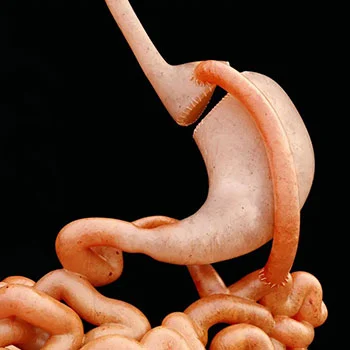What is an umbilical hernia?
An umbilical hernia is a condition where part of the intestine or abdominal tissue protrudes through a weak spot in the abdominal wall near the navel (belly button). This results in a visible bulge or swelling at the umbilical area. Umbilical hernias are more common in infants, particularly premature babies, due to the incomplete closure of the abdominal muscles around the umbilical cord. In adults, umbilical hernias can develop due to factors such as obesity, multiple pregnancies, abdominal surgery, or excessive strain on the abdominal muscles.
Symptoms
Symptoms of an umbilical hernia may include a soft bulge near the belly button that may disappear when lying down and reappear when coughing or straining, discomfort or pain at the site of the bulge, and possible complications such as incarceration (trapping of abdominal contents) or strangulation (loss of blood supply to the herniated tissue).
Causes of umbilical hernia
An umbilical hernia occurs when there is a weakness in the abdominal wall muscles around the belly button (umbilicus), leading to a bulge or protrusion of abdominal contents through the weakened area. Several factors can contribute to the development of an umbilical hernia in infants and adults:
- Congenital weakness: In infants, umbilical hernias are often caused by a congenital weakness in the abdominal wall muscles, which allows abdominal tissue to protrude near the belly button. This weakness may be due to the incomplete closure of the abdominal muscles around the umbilical cord during fetal development.
- Increased intra-abdominal pressure: Factors that increase intra-abdominal pressure can contribute to the development of umbilical hernias in both infants and adults. These factors may include obesity, pregnancy, heavy lifting, chronic coughing, or straining during bowel movements.
- Genetic predisposition: Some individuals may have a genetic predisposition to developing umbilical hernias, as certain genetic factors can influence the strength and integrity of the abdominal wall muscles.
- Multiple pregnancies: Women who have had multiple pregnancies are at higher risk of developing umbilical hernias due to the repeated stretching and weakening of the abdominal muscles during each pregnancy.
- Abdominal surgery: Previous abdominal surgeries, such as appendectomies or cesarean sections, can weaken the abdominal wall and increase the risk of developing an umbilical hernia at the surgical site.
- Chronic constipation: Persistent straining during bowel movements caused by chronic constipation can exert pressure on the abdominal muscles and contribute to the formation of umbilical hernias.
- Ascites: Accumulation of fluid in the abdominal cavity (ascites) due to liver disease, heart failure, or other conditions can increase intra-abdominal pressure and predispose individuals to developing umbilical hernias.
- Age-related muscle weakness: As individuals age, the abdominal muscles may weaken, leading to an increased susceptibility to hernias, including umbilical hernias.
What is umbilical hernia repair surgery?
Umbilical hernia repair surgery is a surgical procedure performed to correct a protrusion of abdominal tissue through a weakened area near the belly button (umbilicus). The surgery aims to push the herniated tissue back into place and reinforce the abdominal wall to prevent the hernia from recurring. During the surgery, The surgeon makes an incision near the umbilical hernia to access the herniated tissue and the weakened area of the abdominal wall. The herniated tissue is gently pushed back into the abdominal cavity through the weakened muscle layer.
When is surgery needed?
Surgery for umbilical hernia is typically recommended in several situations. One common reason for surgery is when the hernia causes symptoms such as pain, discomfort, or tenderness at the hernia site, impacting the individual's quality of life. Additionally, if the hernia is enlarging or becoming more prominent over time, surgical intervention may be necessary to prevent complications and address the underlying weakness in the abdominal wall.
Surgery is also often advised if there is a risk of the herniated tissue becoming trapped (incarcerated) within the abdominal wall, leading to potential complications like bowel obstruction or strangulation. Cosmetic concerns, persistent symptoms despite conservative management, underlying health conditions that increase the risk of complications, and the preference of the patient are all factors that healthcare providers consider when determining the need for umbilical hernia repair surgery.
In pediatric cases, surgical repair may be recommended for children with umbilical hernias that do not resolve on their own or those at risk of complications to prevent issues with growth and development.
What to expect before surgery
Before undergoing umbilical hernia repair surgery, patients can expect the following preparations and procedures:
- Medical evaluation: A healthcare provider will conduct a thorough medical evaluation to assess the patient's overall health, medical history, and any pre-existing conditions that may impact the surgery or recovery.
- Preoperative instructions: Patients will receive specific instructions on how to prepare for surgery, which may include fasting before the procedure, stopping certain medications that can increase the risk of bleeding, and following guidelines for showering and hygiene.
- Anesthesia consultation: Patients may meet with an anesthesiologist to discuss the type of anesthesia (general or local) that will be used during the surgery, as well as any concerns or questions regarding anesthesia administration.
- Blood tests and imaging: Blood tests, such as a complete blood count (CBC) and coagulation studies, may be performed to assess the patient's clotting ability and overall health. In some cases, imaging studies like ultrasound or CT scan may be ordered to evaluate the hernia and surrounding structures.
- Smoking cessation: Patients who smoke may be advised to quit smoking before surgery, as smoking can impair wound healing and increase the risk of complications.
- Arrangements for recovery: Patients should make arrangements for transportation to and from the surgical facility on the day of the procedure, as well as for assistance with activities of daily living during the initial recovery period.
- Preoperative diet: Following dietary recommendations provided by the healthcare team can help optimize the patient's nutrition and hydration status before surgery, promoting better recovery outcomes.
- Informed consent: Before the surgery, patients (or their parents if they are under the legal age) will be asked to sign a consent form indicating their understanding of the procedure, potential risks, benefits, and alternatives to surgery.
- Questions and concerns: Patients are encouraged to ask any questions or voice concerns they may have about the surgery, recovery process, or postoperative care during preoperative appointments with the healthcare team.
By following these preoperative preparations and guidelines, patients can help ensure a smooth and successful umbilical hernia repair surgery experience. Open communication with the healthcare team and adherence to preoperative instructions are key to promoting optimal outcomes and minimizing potential risks associated with the surgical procedure.
What to expect during surgery
During umbilical hernia repair surgery, patients can expect the following steps and procedures:
- Anesthesia administration: The patient will be given either general anesthesia or local anesthesia with sedation, depending on the specific surgical approach and the patient's medical condition. This ensures that the patient is comfortable and pain-free throughout the procedure.
- Incision: The surgeon will make an incision near the umbilical hernia to access the herniated tissue and the weakened area of the abdominal wall. The size and location of the incision may vary based on the size of the hernia and the surgical technique chosen.
- Hernia reduction: The protruding abdominal tissue (such as part of the intestine) will be gently pushed back into the abdominal cavity through the weakened muscle layer. This step aims to correct the hernia and relieve pressure on the surrounding tissues.
- Repair technique: The surgeon may use sutures to close the opening in the abdominal wall or reinforce the area with a synthetic mesh to provide additional support and reduce the risk of hernia recurrence. The choice of repair technique depends on the size of the hernia, the patient's anatomy, and other factors.
- Closure: Once the repair is completed, the incision is closed with sutures or surgical staples. A sterile dressing may be applied to the surgical site to protect the wound and promote healing.
- Monitoring: Throughout the surgery, the patient's vital signs, such as heart rate, blood pressure, and oxygen levels, will be closely monitored by the surgical team to ensure safety and proper management of any potential complications.
- Duration: The duration of umbilical hernia repair surgery varies depending on the complexity of the hernia, the chosen repair technique, and any unforeseen challenges encountered during the procedure. Most surgeries can be completed within one to two hours.
- Postoperative care: After the surgery is completed, the patient will be monitored in the recovery area before being transferred to a postoperative care unit or discharged home. Instructions on wound care, activity restrictions, pain management, and follow-up appointments will be provided to support the patient's recovery.
By understanding the steps involved in umbilical hernia repair surgery, patients can feel more informed and prepared for the surgical experience. Open communication with the surgical team and adherence to postoperative instructions are crucial for promoting successful outcomes and a smooth recovery process following the procedure.
Recovery and aftercare
After undergoing umbilical hernia repair surgery, patients can expect the following recovery and aftercare guidelines:
- Pain management: The healthcare provider may prescribe pain medications to manage postoperative discomfort. Follow the prescribed dosages and instructions for pain relief as directed.
- Wound care: Keep the surgical incision site clean and dry as instructed by the healthcare team. Follow guidelines for changing dressings, showering, and avoiding activities that may strain the incision area.
- Activity restrictions: Limit physical activities, heavy lifting, and strenuous exercises as advised by the healthcare provider during the initial recovery period to prevent strain on the abdominal muscles and promote proper healing.
- Diet and hydration: Maintain a balanced diet rich in nutrients to support healing and hydration. Follow any dietary recommendations provided by the healthcare team to promote recovery and prevent constipation.
- Follow-up appointments: Attend all scheduled follow-up appointments with the healthcare provider to monitor the healing progress, remove sutures or staples if needed, and address any concerns or complications that may arise during the recovery period.
- Resuming normal activities: Gradually reintroduce normal activities and exercises based on the guidance of the healthcare provider. Avoid activities that may put stress on the abdominal muscles until cleared by the medical team.
- Symptom monitoring: Monitor the surgical site for any signs of infection, such as increased redness, swelling, warmth, or drainage. Contact the healthcare provider if you experience persistent or worsening symptoms following the surgery.
- Supportive garments: If recommended by the healthcare provider, wear supportive garments such as an abdominal binder to provide gentle compression and support to the abdominal area during the recovery process.
- Scar care: Follow scar care instructions provided by the healthcare team to promote optimal healing and minimize the appearance of scars. Use recommended topical treatments or silicone sheets as directed.
- Physical therapy: In some cases, physical therapy or gentle abdominal exercises may be recommended to help strengthen the abdominal muscles and improve mobility after the surgery. Follow the exercise plan provided by the healthcare provider.
By adhering to these recovery and aftercare guidelines, patients can support the healing process, minimize complications, and promote a smooth and successful recovery following umbilical hernia repair surgery. Open communication with the healthcare team and proactive involvement in self-care is essential for achieving optimal outcomes and restoring normal function after the surgical procedure.
Risks of umbilical hernia surgery
While umbilical hernia repair surgery is generally considered safe and effective, like any surgical procedure, it carries certain risks and potential complications. Some of the risks associated with umbilical hernia surgery include:
- Infection: There is a risk of infection at the surgical site, which can manifest as redness, swelling, warmth, or drainage. Proper wound care and hygiene practices can help reduce the risk of infection.
- Bleeding: During or after surgery, there is a possibility of bleeding at the incision site. In some cases, excessive bleeding may require additional interventions or blood transfusions.
- Hematoma: Formation of a hematoma (collection of blood) at the surgical site can lead to swelling, pain, and potential complications. Drainage or surgical intervention may be necessary to address a significant hematoma.
- Seroma: Accumulation of fluid in the surgical area (seroma) can occur postoperatively, leading to swelling and discomfort. In some cases, drainage may be required to resolve a persistent seroma.
- Recurrence: Despite successful repair, there is a risk of hernia recurrence, especially if the abdominal muscles do not heal properly or if there is increased intra-abdominal pressure due to factors such as obesity or heavy lifting.
- Nerve damage: Injury to nearby nerves during surgery can result in temporary or permanent numbness, altered sensation, or pain in the abdominal region or surrounding areas.
- Adverse reaction to anesthesia: Rarely, patients may experience adverse reactions to anesthesia, such as allergic reactions, respiratory complications, or cardiovascular issues.
- Scar tissue formation: The formation of excessive scar tissue (keloids or hypertrophic scars) at the incision site can lead to aesthetic concerns or discomfort. Scar management techniques may be recommended to minimize scarring.
- Chronic pain: Some patients may experience chronic or persistent pain at the surgical site, which can impact daily activities and quality of life. Pain management strategies and follow-up care may be necessary to address this issue.
- Damage to surrounding structures: In rare cases, there is a risk of inadvertent damage to nearby structures such as blood vessels, intestines, or organs during surgery, which may require additional interventions to correct.
Patients should discuss these potential risks with their healthcare provider before undergoing umbilical hernia repair surgery and follow preoperative and postoperative instructions carefully to minimize complications. Promptly reporting any unusual symptoms or concerns to the medical team can help ensure timely intervention and appropriate management of any postoperative issues.
How much does it cost?
The cost of umbilical hernia repair surgery can vary depending on several factors, including the geographical location, the healthcare provider or facility performing the procedure, the specific surgical technique used, the complexity of the hernia, the type of anesthesia administered, any additional tests or imaging studies required, and postoperative care expenses.
In the United States, the average cost of umbilical hernia repair surgery can range from $4,000 to $12,000 or more. This cost typically includes the surgeon's fees, anesthesia fees, facility fees (hospital or surgical center), preoperative evaluation costs, postoperative care, and follow-up appointments.
You should check with your healthcare provider or healthcare facility to obtain a personalized cost estimate for umbilical hernia repair surgery based on your individual circumstances and insurance coverage.
Is umbilical hernia repair covered by insurance?
In many cases, umbilical hernia repair surgery is covered by health insurance, including private insurance plans, Medicare, and Medicaid, depending on the specific policy terms, coverage limitations, and medical necessity criteria.
Insurance providers may require documentation of the medical necessity of umbilical hernia repair surgery, such as symptoms, physical examination findings, imaging studies, and the impact of the hernia on the patient's health and quality of life. Patients are often advised to seek care from healthcare providers and facilities that are in-network with their insurance plan to maximize coverage and minimize out-of-pocket expenses. Out-of-network care may result in higher costs or reduced coverage.
Some insurance plans may require preauthorization or prior approval for umbilical hernia repair surgery to confirm the necessity of the procedure and ensure coverage eligibility. Failure to obtain preauthorization may result in coverage denial.
Patients should review their insurance policy to understand the out-of-pocket maximum, which represents the maximum amount they are responsible for paying toward covered healthcare services within a given period. Once the out-of-pocket maximum is reached, the insurance plan typically covers additional costs at 100%.
FAQs
Is an umbilical hernia dangerous?
In general, umbilical hernias are not considered dangerous, but they can cause discomfort and complications if left untreated. It is important to monitor the hernia and consult a healthcare provider for evaluation and treatment recommendations.
How long does an umbilical hernia surgery take?
The duration of umbilical hernia repair surgery can vary depending on the size of the hernia, the surgical technique used, and any additional procedures required. On average, the surgery typically takes around 30 minutes to an hour.
Will an umbilical hernia come back after surgery?
While umbilical hernia repair surgery is designed to permanently close the opening in the abdominal wall, there is a small risk of hernia recurrence, especially if the abdominal muscles do not heal properly or if there is increased intra-abdominal pressure. Following postoperative care guidelines can help minimize the risk of recurrence.
What happens if an umbilical hernia is left untreated?
If left untreated, an umbilical hernia may persist and potentially increase in size over time. In some cases, complications such as incarceration (trapping of abdominal contents in the hernia sac) or strangulation (loss of blood supply to trapped tissues) may occur, leading to severe pain, bowel obstruction, or tissue damage, which may require emergency surgery.
When is the best age to get my kid’s umbilical hernia repaired?
The best age for a child to undergo umbilical hernia repair surgery is typically around 3-4 years old if the hernia has not resolved on its own and is causing symptoms or complications. By this age, the abdominal muscles are usually stronger, reducing the risk of hernia recurrence post-surgery.
What anesthesia is used for umbilical hernia repair in babies and infants?
For umbilical hernia repair in babies and infants, general anesthesia is commonly used to ensure the child remains unconscious and pain-free during the surgery. An anesthesiologist will carefully monitor the baby's vital signs and adjust the anesthesia dosage as needed to ensure a safe and comfortable surgical experience.
Can umbilical hernia be corrected without surgery?
While some umbilical hernias in infants may resolve on their own within the first few years of life as the abdominal muscles strengthen, larger or persistent hernias often require surgical repair to prevent complications and ensure optimal outcomes. Non-surgical methods are not typically effective in correcting umbilical hernias.




